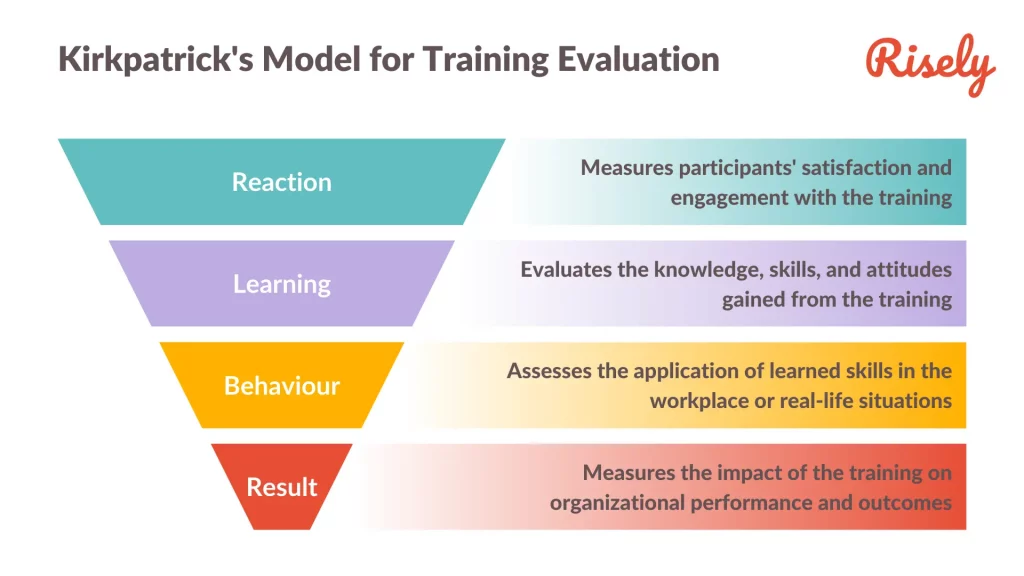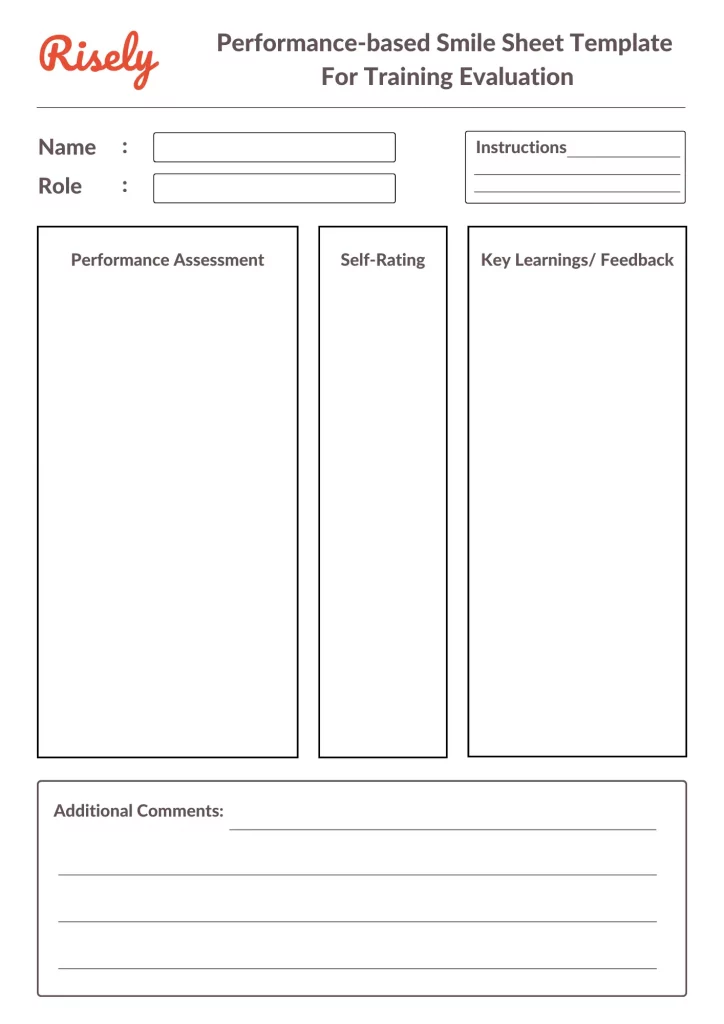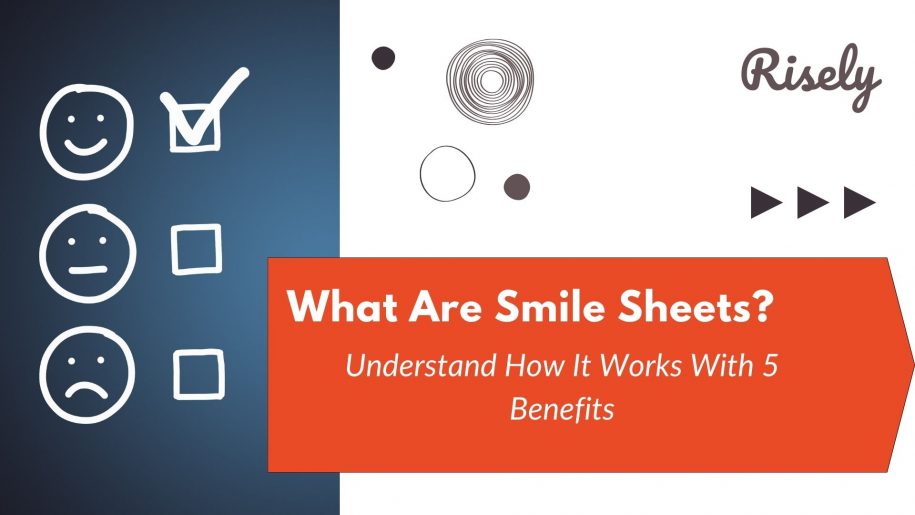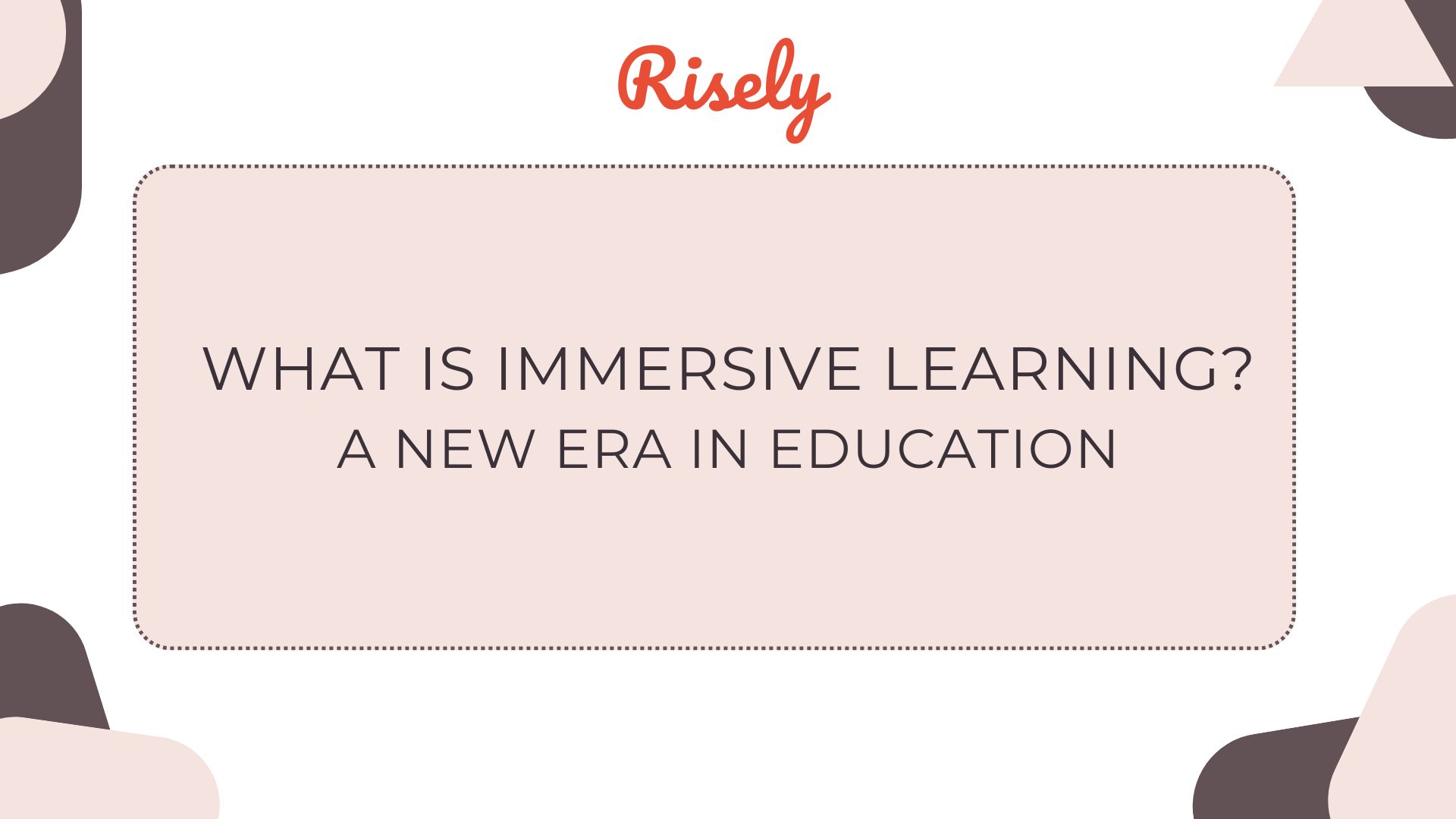What Are Smile Sheets? Understand How It Works With 5 Benefits
Have you ever wondered if there’s a better way to gather feedback and assess performance in your programs or events? Are you tired of traditional evaluations that fail to provide meaningful insights? Well, say hello to smile sheets – an innovative approach to evaluation that goes beyond measuring mere satisfaction. In this blog, we’ll understand smile sheets, their effectiveness, and how they can transform your evaluation process. So, what exactly are smile sheets, and how do they differ from traditional evaluations? How can you design smile sheets that capture valuable data and drive improvements? Let’s jump in to get all the answers!What are Smile Sheets?
Smile sheets are simple, questionnaire-style forms administered to participants immediately after an event or training session. The name “smile sheets” originates from the commonly used visual rating scales in these forms, where participants are asked to rate their experience by marking smiley faces, numerical scales, or other visual indicators. Smile sheets serve two primary purposes: assessing participant satisfaction and gathering feedback on learning outcomes. They provide organizations valuable insights into their programs’ effectiveness, identify improvement areas, and help make data-driven decisions. By gathering employee feedback, organizations can better understand how well their initiatives are meeting the needs of their target audience and make necessary adjustments to optimize their offerings.Importance of Smile Sheets
Smile sheets are not just response forms but powerful tools that instructional designers use to gather valuable data about training effectiveness. When learners fill out smile sheet questions, they provide stakeholders with useful feedback about their learning experience, identifying areas for improvement and gaps in knowledge. Results from smile sheets can lead to performance interventions and improvements in job performance. With the help of Kirkpatrick’s model and Will Thalheimer’s meta-analyses, it has been proven that traditional smile sheets are less effective than performance-focused ones. Instructional designers need to radically rethink a dangerous art form by replacing happy sheets with smile sheets that provide actionable results for improving actual job tasks.
Traditional VS Performance based Smile Sheets
Traditional Smile Sheets
For many years, traditional smile sheets have been the go-to evaluation tool for gathering participant feedback. They typically consist of generic satisfaction rating scales, open-ended questions, and demographic information. Key Characteristics:- General Satisfaction Measurement: Traditional smile sheets assess participants’ overall satisfaction with the program or event. They often include rating scales with smiley faces or numerical scales for participants to indicate their level of satisfaction.
- Subjective Responses: Participants are asked to provide subjective responses, which may be influenced by factors unrelated to the program, such as their mood at the time of rating or personal biases.
- Limited Insights into Learning Outcomes: Traditional smile sheets may lack specific questions about learning outcomes or performance improvements. They typically do not assess whether participants have acquired new skills or knowledge or if they can apply what they have learned.
- Difficulty in Identifying Areas for Improvement: With a focus on general satisfaction, traditional smile sheets may not provide sufficient information to identify specific areas where improvements can be made. They may not uncover potential gaps in the program content, delivery methods, or employee engagement.
- General participant satisfaction is the primary focus.
- The evaluation aims to collect qualitative feedback and open-ended responses.
- There is a need for a quick and easy evaluation tool to gather overall impressions.
- The program or event being evaluated does not require specific performance metrics or behavior change assessment.
- Limited time or resources are available for evaluation.
Performance-Focused Smile Sheets
Performance-focused smile sheets address the limitations of traditional smile sheets by shifting the focus from generic satisfaction to specific performance outcomes. These evaluation tools aim to gather more actionable data related to learning achievements and behavior change. Key Characteristics:- Targeted Performance Assessment: Performance-focused smile sheets include questions that directly measure specific performance outcomes. They assess participants’ ability to apply newly acquired knowledge and skills, behavioral changes, and the practical impact of the program.
- Objective and Measurable Responses: Performance-focused smile sheets strive to gather more accurate and measurable responses. They often use clear and concise questions that require participants to provide specific examples or demonstrate their understanding.
- Actionable Insights: Performance-focused smile sheets provide organizations with actionable insights by measuring specific performance outcomes. These insights help identify areas for improvement, optimize program content, and make informed decisions to enhance future offerings.
- Benchmarking and Comparison: Performance-focused smile sheets enable benchmarking and comparing different programs or interventions. Organizations can evaluate the effectiveness of various initiatives and identify best practices that yield the desired outcomes.
- Measuring specific performance outcomes and learning achievements is crucial.
- Objective and measurable data is needed to assess the impact of the program.
- Actionable insights are desired to identify areas for improvement and drive program optimization.
- Comparative analysis between different programs or interventions is necessary.
- There is a focus on behavior change assessment and the practical application of knowledge and skills.

How to design and implement a Performance Based Smile Sheet
Designing and implementing a performance based smile sheet in the workplace requires careful planning and consideration of the specific performance outcomes you want to measure. Here’s a step-by-step guide to help you design and implement a performance-based smile sheet in the workplace:- Identify Performance Objectives: Clearly define the performance objectives you want to assess in the workplace. Determine the critical skills, behaviors, or outcomes relevant to job roles or training programs.
- Select Appropriate Performance Metrics: Choose performance metrics that align with the identified objectives. For example, if you want to measure customer service skills, metrics include responsiveness, problem-solving, and customer satisfaction ratings. Ensure that the selected metrics are measurable and provide meaningful insights.
- Craft Targeted Questions: Develop questions that directly assess the chosen performance metrics. Design questions that require participants to provide specific examples to demonstrate their understanding or rate their performance on a scale. Use clear and concise language to avoid ambiguity.
- Consider Response Formats: Determine the response formats that best suit the questions and performance metrics. This could include rating scales, multiple-choice options, or open-ended responses. Select formats that allow participants to provide the most accurate and meaningful feedback.
- Balance Quantitative and Qualitative Data: Incorporate quantitative and qualitative data collection. While rating scales and multiple-choice questions provide quantitative data, open-ended questions allow participants to provide detailed feedback and examples. Striking a balance between the two data types provides a comprehensive view of performance.
- Create a User-Friendly Format: Design the smile sheet in a user-friendly format. Use clear headings, logical flow, and visually appealing layouts. Ensure participants can easily navigate the questions and respond without confusion or frustration.
- Consider Anonymity and Confidentiality: Assure participants that their responses will remain anonymous and confidential. This helps encourage honest feedback and reduces potential biases. Use unique identifiers or codes instead of personal identifiers on the smile sheet.
- Pilot Testing and Refinement: Conduct pilot testing with a small group of employees before implementing the smile sheet on a larger scale. Gather their feedback on question clarity, response formats, and overall usability. Make necessary refinements based on their input.
- Communicate the Purpose and Process: Communicate the purpose of the performance-based smile sheet to employees. Explain how their feedback will be used to drive improvement and enhance performance. Provide instructions on completing the smile sheet and any specific guidelines or criteria to consider.
- Implement and Collect Data: Administer the performance-based smile sheets to employees based on a predetermined timeline. Allow sufficient time for employees to complete the smile sheets and encourage participation. Collect the completed smile sheets and ensure secure storage of the data.
- Analyze and Interpret Data: Analyze the collected data to gain insights into performance outcomes. Use quantitative analysis to summarize rating scale data and identify trends or patterns. Qualitative responses can be categorized and analyzed thematically. Interpret the data to identify strengths and areas for improvement.
- Implement Actionable Changes: Use the insights gained from the smile sheet data to drive performance improvement. Identify areas that require attention and develop strategies to enhance performance based on the feedback received. Implement actionable changes and monitor the impact on performance.
- Continuous Evaluation and Iteration: Regularly evaluate and refine the performance-based smile sheet based on ongoing feedback and evolving performance objectives. Continuously seek ways to improve the evaluation process and make the smile sheet more effective in measuring and enhancing workplace performance.
Other Interesting Reads
Examples of Questions to Include in Smile Sheets
Customer Service Performance
a) On a scale of 1 to 5, rate your ability to communicate with customers effectively. b) How often do you go above and beyond to exceed customer expectations? c) Provide an example of a challenging customer interaction you successfully resolved.Training Program Evaluation
a) Did the training program provide you with the necessary knowledge and skills to perform your job effectively? (Yes/No) b) On a scale of 1 to 10, how confident do you feel in applying what you learned in the training? c) Share one specific change you have implemented due to the training.Leadership Effectiveness
a) Rate your supervisor’s ability to provide clear direction and guidance. b) How well does your supervisor support your professional development? c) Provide an example of a time when your supervisor effectively resolved a conflict within the team.Team Collaboration
a) On a scale of 1 to 5, rate your team’s collaboration level. b) How frequently do team members support and assist each other? c) Share an example of a successful team project where collaboration played a significant role.Presentation or Workshop Evaluation
a) Did the presenter effectively engage the audience throughout the presentation/workshop? (Yes/No) b) Rate the presenter’s ability to explain complex concepts clearly and understandably on a scale of 1 to 10. c) What was the most valuable takeaway from the presentation/workshop? These questions are just for reference and inspiration, and the specific questions you include in your smile sheets should align with your objectives and workplace context. Tailor the questions to suit the performance outcomes you want to measure and ensure they are relevant to the specific roles or programs being evaluated.Conclusion
Smile sheets are a valuable tool for evaluating performance and gathering participant feedback. Traditional smile sheets focus on satisfaction, while performance-focused smile sheets assess specific outcomes and skills. By designing effective smile sheets, you can collect meaningful data to drive improvement in the workplace or educational settings. Consider the objectives, use targeted questions, and balance quantitative and qualitative data. Implement the smile sheets with clear instructions, analyze the data, and take actionable steps for improvement. With careful planning and continuous refinement, smile sheets can provide valuable insights to enhance future programs, events, and overall performance. Sign up for Risely to test your skills and learn effective leadership development methods, how to give feedback constructively, and how to receive feedback.Focus on active listening to spot gender inequality and bias in your team.
Take the free active listening skill assessment to identify weak areas and get support.
Other Related Blogs
What is Immersive Learning? A New Era in Education
In this blog, you’ll learn what is immersive learning and how it is changing training, increasing engagement, and influencing the future of workforce development. … Read More
The Ultimate Guide To Learning Design Tools For 2025
This blog post lists eight essential learning design tools that you need to transform your training programs into powerful learning journeys that inspire and empower every learner to reach their…
Choosing The Right Training Evaluation Tool For Optimal Results
In this blog, we’ll explore how selecting the right training evaluation tool leads to improved performance, more effective training programs, and better overall outcomes for your organization. … Read More
Training Delivery Simplified: Methods, Competencies, and Best Practices
In this blog, we’ll walk you through the training delivery process, the competencies you need, an example of a practical training delivery plan and 8 effective methods. … Read More


